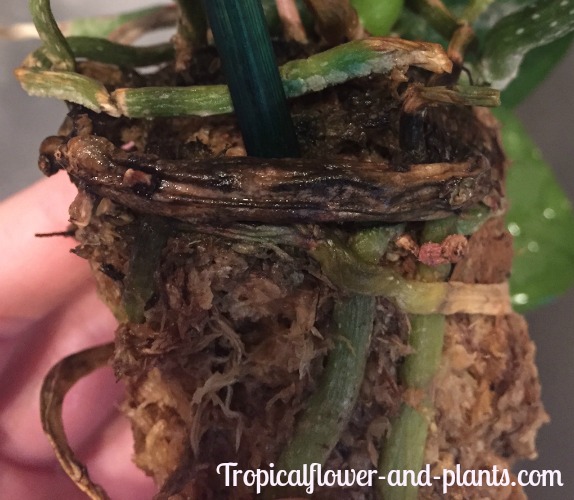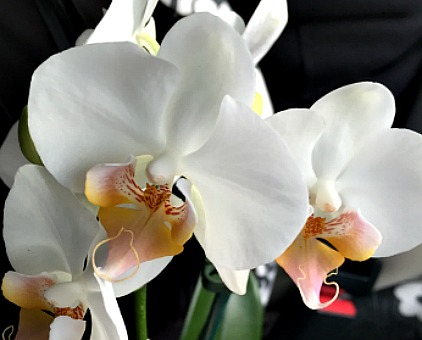|
|
Phalaenopsis Orchids
Phalaenopsis orchids may also be known as moth orchids and are considered one of the hardier orchids you can purchase in the trade. Most of these orchids are purchased as gifts for others but come with little or no instructions. Unfortunately, many of these orchids will be thrown away after the last bloom falls. The worse case scenario, the person will forget about the orchid and it will slowly die from not receiving the proper nutrients.
On a positive, note in the right conditions a healthy Phalaenopsis will bloom repeatedly throughout the year. This past year several of my moth orchids bloomed not only several times but for months.
If you happen to be looking for an inside orchid this one is definitely for you! These beautiful tropical flowers grow awesome as either a houseplant or an outside plant.
In my house I have several that grow and constantly re-bloom in my bathroom window. I also have ones that line my entrance making it the perfect tropical oasis.
This is a general overview on how to care for your Phalaenopsis orchids. There is a vast variety to pick from so before purchasing your orchid make sure to ask questions on that specific species. The needs may fluctuate slightly.
Light
Theses gorgeous tropical flowers do best in indirect sunlight. Since they are known for growing indoors, their favorable spot would be a bright window that faces east. If you happen to have a shaded west or south window that would also be suitable.
If your daring, which I am......I have seen and have Phalaenopsis orchids wrapped around trees that receive direct morning sunlight.
Temperature
The ideal temperature for Phalaenopsis orchids are as followed: night temperature should be above 60 degrees F and day temps should range between 75 and 85 degrees F. Living in south Florida our temps are higher so this forces faster growth. Knowing this the humidity also has to keep up with the hotter temps. Every now and then we get a surprise drop in temperatures and may cause beginning blooms to drop. Covering or bringing in your tropical flower may help preserve the blooms.
Humidity
You always want the humidity to have movement especially if they are in a greenhouse! Humidity should be between 50 -80%. Phalaenopsis located in the house should be placed on a tray of gravel, partially filled with water. The tropical flower should never sit in water for a long period of time.
Watering
Phalaenopsis orchids do not have a water storage like other orchid species. They can only count on their leaves for their water. Due to their anatomy it is imperative that they get plenty of water.
Rule of thumb…. never let them completely dry out and always water during the morning hours. During the different season you may need to water more or less to keep up with it.
Fertilizer
Consistent fertilizer is recommended all year long! During the warmer months the orchids tend to do most of their growing. The recommended balance is 20-20-20 or something similar every 2-3 weeks.
Some orchid growers/ nurseries tend to fertilizer more often, however, this is done with a diluted orchid mixture. If you would like to fertilize your orchids often make sure you read the proper measurements for diluting your current fertilizer.
Fertilizer is an aid for the orchid so if you happen to forget no biggie. Your Phalaenopsis orchid will not die from this. I am not saying that you shouldn't ever fertilize. In personal experience I can notice a difference with orchids that are fertilize rather than not.
Re-Potting
Repotting the Palaenopsis orchid is best during the spring after the tropical plant has flowered.
Here are some indications on when to repot your Phalaenopsis orchid:
1) The potting medium has begun to break down and the water drains poorly.
2) The roots or rhizome of the plant are protruding over the sides of the pot.
3) The roots of the orchid are completely root bound.
Adult Orchids: You should re-pot your adult Phalaenopsis orchid about every 3 years. Re-pot these orchids in a porous mixture. They can stay in this mix until it has begun to decompose. This will probably take about 2 years.
Remember do not leave them in a soggy mixture. If you notice this occurring re-pot immediately!!! The soggy mix will cause root rot.
Orchid Seedling: Orchid Seedlings will grow much faster so they can be re-potted every year. You should use a fine grade medium mix for the orchid seedlings
When you repot your orchid you want to make sure you remove all of the old medium. I also cut away some of the dead or soft roots (the dead ones will appear brown) to make room for new ones. When completing the removal step you want to make sure you have a clean blade.
 |
Notice the brown shriveled up roots in the picture. I would carefully remove those to make room for knew growth. |
Place a handful of the new mix at the bottom of the pot. The pot should be the next size up, you don’t want it to be too large.
If the pot is to large the roots will worry more about their growth instead of the blooms.
|
This is an examples of a clear pot that I have around my house in case I need to transplant an orchid. In the recent seasons I had babies growing out of my mature orchids. I will use the smaller clear pot to give them a new home! |
Next, I place the orchid in and will begin to add more of the mix around the orchid. At this point you may need to stake it to keep it upright. Do not pack the medium you want to make sure that air can circulate around.
|
These stakes are small enough for your delicate orchid. I like the natural ones because some of the green ones will stain your hands. I'm always looking for clips so when I saw this deal I had to order them! |
Check out more incredible photos on Phalaenopsis Orchids






New! Comments
Leave me any questions and comments in the box below.